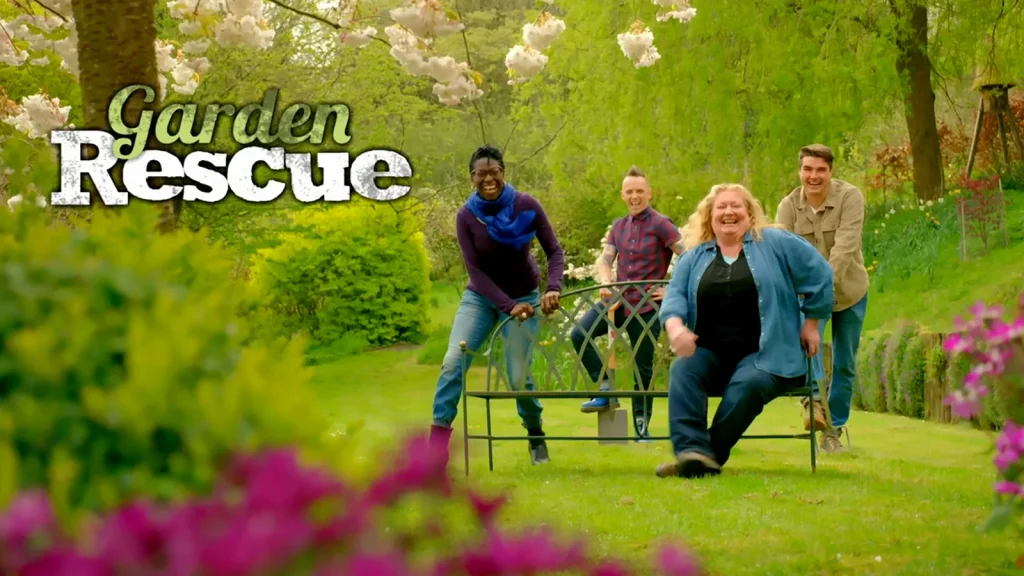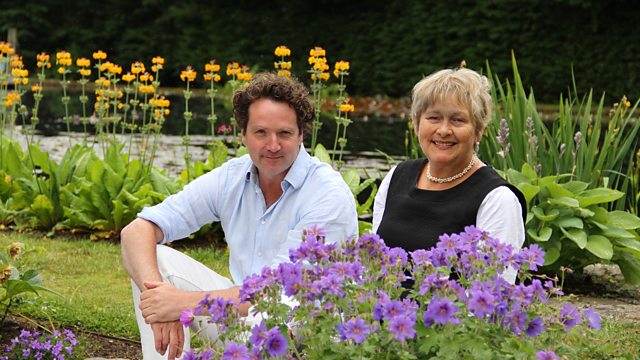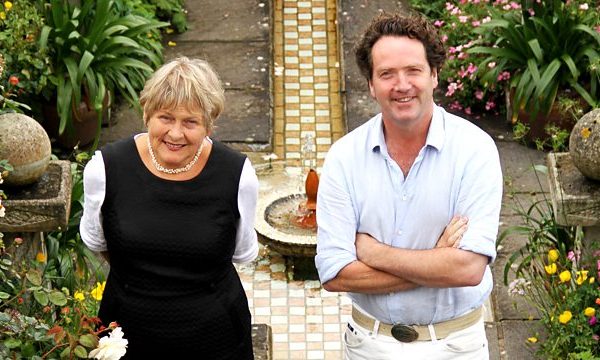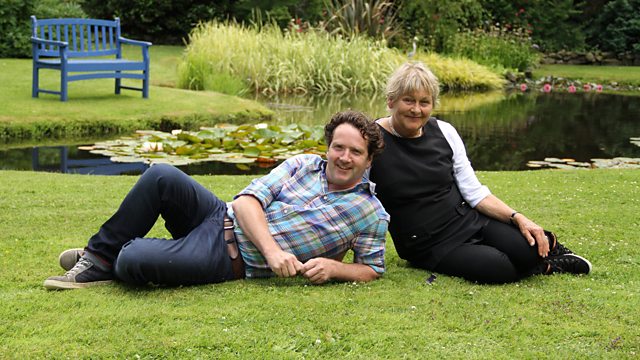In Garden Rescue episode 32 2024, Julie and Phillip face a challenge familiar to many couples: finding time together amidst demanding work schedules. Living in Rocester, Julie works shifts in an emergency unit, which means she and Phillip often feel like ships passing in the night. They dream of transforming their modest garden—enclosed by brick walls—into a tranquil, wildlife-focused haven where they can relax together whenever those precious moments align. With a budget of £3,000, they’re determined to make the most of their small garden and turn it into a vibrant, welcoming space.
This episode of Garden Rescue is all about maximizing potential on a budget. With garden designers Lee Burkhill and Flo Headlam leading the transformation, creativity and resourcefulness take center stage. Their mission? To craft a wildlife-friendly space where nature can thrive, while also offering Julie and Phillip a serene place to unwind. Despite the budget constraints, Lee and Flo prove that imagination can achieve wonders, even with a smaller price tag.
The first challenge was expanding the social area of the garden without breaking the bank. The team decided to source patio slabs that matched the existing ones, allowing them to extend the patio into a larger social hub without the cost of starting from scratch. It was a practical yet aesthetically pleasing move, one that set the tone for the rest of the makeover. By matching the existing materials, they ensured a seamless look that makes the garden feel more expansive and unified.
But what really sets this garden apart is the way it embraces nature. Julie and Phillip wanted their garden to be more than just a place to sit—they wanted it to teem with life. With this vision in mind, the designers focused on wildlife-friendly features. Lee’s key contribution was something truly unexpected—a “rabbit out of the hat” moment, if you will. He introduced the idea of incorporating bat boxes into the design, a move that would not only add character to the garden but also attract an often-overlooked species of local wildlife.
To bring this idea to life, Flo built three custom bat boxes to be placed in the lower part of the garden, creating cozy homes for these nocturnal creatures. Meanwhile, Lee took things up a notch by installing a four-meter-high freestanding bat post, a unique structure designed to attract bats from the surrounding area. The bat post stands tall, almost like a watchtower, inviting the little winged residents to take up shelter. This feature not only serves as a haven for bats but also adds an interesting visual element to the garden, standing out against the brick walls and lending a whimsical touch to the overall design.
The curved timber path that winds its way through the garden is another brilliant budget-friendly feature. It adds a sense of movement and exploration to the space, guiding Julie and Phillip on a gentle stroll through their newly transformed oasis. The timber path, with its soft curves, creates a natural flow and draws the eye across the garden, making it feel larger and more dynamic. The combination of wood and greenery brings a rustic charm that’s both inviting and soothing—perfect for those times when they can finally steal a few moments together to relax.
Throughout the episode, Lee and Flo showcase their talents not only in garden design but also in understanding the emotional connection people have with their outdoor spaces. For Julie and Phillip, this garden isn’t just about aesthetics—it’s about creating a sanctuary, a place where they can reconnect with each other and with nature. The designers’ thoughtful touches, from the expanded patio to the carefully placed bat boxes, reflect the couple’s desire for a space that’s both practical and full of life.
The use of natural materials, like the timber path and the reclaimed patio slabs, helps to create a cohesive look that feels at home in its surroundings. By prioritizing sustainability and wildlife-friendly features, Lee and Flo not only met Julie and Phillip’s brief but also crafted a garden that contributes positively to the local environment. It’s a reminder that even small gardens can make a big difference when it comes to supporting local wildlife.
Garden Rescue episode 32 2024
Julie and Phillip’s garden makeover is a testament to what can be achieved with a bit of creativity, a modest budget, and a lot of heart. Lee Burkhill and Flo Headlam took on the challenge with enthusiasm, proving that you don’t need a huge budget to create something truly special. By focusing on wildlife, sustainability, and clever use of space, they transformed a simple brick-walled garden into a thriving, peaceful retreat.
As the episode draws to a close, Julie and Phillip finally have a space where they can unwind together—a garden that’s not just a backdrop for their busy lives, but a living, breathing extension of their home. The bat boxes and the towering bat post add a sense of wonder, reminding them that they’re sharing their sanctuary with the creatures of the night. The timber path invites them to wander, to explore, and to reconnect with nature and each other.
Garden Rescue episode 32, 2024, is an inspiring reminder of what’s possible when thoughtful design meets a desire to embrace nature. Whether you’re working with a small garden or a limited budget, the ideas showcased in this Rocester transformation—from the bat-friendly features to the budget-savvy use of materials—prove that a little creativity can go a long way. For anyone looking to embark on their own garden makeover, this episode is filled with inspiration, demonstrating that with the right approach, even the smallest of gardens can become a cherished haven.
Conclusion Garden Rescue episode 32 2024
In the end, Julie and Phillip’s garden stands as a testament to what can be achieved with imagination, heart, and a modest budget. It’s more than just a garden—it’s a living sanctuary that reflects their love for nature and each other. The transformation has turned their once simple space into a wildlife haven, a peaceful retreat, and a place to reconnect after long days apart.
The bat boxes, crafted with care and positioned thoughtfully, have become symbols of hope and renewal. They remind us that even in the quietest corners, life can flourish with a little help. The towering bat post adds a touch of magic, as if inviting nature’s night-time visitors to join in the story. It’s a beautiful reminder that we share our space with countless other beings, and that our small actions can create big ripples in the natural world.
The curved timber path, winding through the garden like a gentle stream, adds a sense of adventure and discovery. It encourages Julie and Phillip to take their time, to wander, and to cherish the moments they spend together in their own private oasis. The expanded patio, meanwhile, has become the heart of their garden—a place to sit, to laugh, and to create memories under the open sky.
This garden makeover is more than just a renovation; it’s a reflection of the power of creativity and a reminder that beauty and functionality can coexist harmoniously. Lee and Flo’s thoughtful design has turned a small, walled space into a thriving, welcoming retreat. It’s proof that with a little resourcefulness, even the most ordinary gardens can be transformed into extraordinary places.
For Julie and Phillip, this is now a garden that breathes—one that welcomes not only them but also the wildlife they cherish. It’s a space that invites them to pause, to reconnect, and to share their lives with the creatures of the night. As they sit on their patio or stroll along the timber path, they’re reminded that nature, like love, flourishes when given the right care. And perhaps that’s the greatest takeaway from this transformation—that with patience, vision, and a touch of creativity, any space can become a cherished haven.
FAQ Garden Rescue episode 32 2024
Q: How can I create a wildlife-friendly garden on a budget?
A: Start by incorporating simple elements like bird feeders, bat boxes, and native plants. Reclaimed materials, like patio slabs or timber, can add functionality while keeping costs low. Prioritizing natural features attracts wildlife and transforms your garden into a peaceful retreat.
Q: What features make a garden welcoming for both people and wildlife?
A: A well-designed garden balances elements for relaxation and nature. Including bat boxes, a curved timber path, and cozy seating areas invites both wildlife and people to enjoy the space. Mixing natural materials with greenery helps create a harmonious environment.
Q: How can I make a small garden feel larger?
A: To make a small garden feel larger, use features that guide the eye, like a winding path. Curved timber paths create a sense of movement, making your garden appear more dynamic. Using matching materials throughout, like reclaimed patio slabs, creates a unified, expansive look.
Q: What are the benefits of adding bat boxes to my garden?
A: Bat boxes provide a safe space for these beneficial nocturnal creatures, which help control insects naturally. They also add character to your garden, making it feel like a part of the broader ecosystem. It’s a great way to support local wildlife.
Q: How can I add character to a brick-walled garden?
A: Adding features like a freestanding bat post, custom bat boxes, and a winding timber path can create visual interest in a brick-walled garden. These elements add a touch of magic, turning an ordinary space into a unique and inviting haven, perfect for both wildlife and relaxation.




